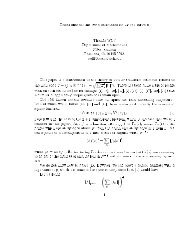Brownian motion and harnack inequality for ... - Math.caltech.edu
Brownian motion and harnack inequality for ... - Math.caltech.edu
Brownian motion and harnack inequality for ... - Math.caltech.edu
You also want an ePaper? Increase the reach of your titles
YUMPU automatically turns print PDFs into web optimized ePapers that Google loves.
224 M. AIZENMAN AND B. SIMON<br />
Proof: We begin by computing<br />
E( T 2 t; b(r) E A ) =I E,J T 2 t; b(r) E A)#(x)d”x.<br />
This is precisely (see [31])<br />
with xA the indicator function of A; thus the conditional distribution of b(t)<br />
subject to T h t is exactly #(x)d”x. It follows by the Markov property that<br />
E(f(b( 7’)); T L I)<br />
is independent of r, so that the claimed independence is proven. Moreover,<br />
taking A = s2 in the above equation, we find that<br />
from which (3.4) immediately follows.<br />
P( T 2 t ) = e-a‘,<br />
Remark. A similar argument shows that the probability distribution <strong>for</strong><br />
{ b( T - s )JoCs~ I conditional on T 2 t is independent of T. This fact should be<br />
remembered in thinking about the constructions below.<br />
For the case where !2 is a ball, the E-distribution of b( T) is obviously du(y)<br />
by symmetry. The <strong>for</strong>mula <strong>for</strong> more general !2 is discussed extensively in<br />
Appendix 3. If yo E as2 <strong>and</strong>, neary,, as2 is a smoothly embedded submanifold of<br />
R”. then the E-distribution of the exit place <strong>for</strong> b( T) is<br />
(3.5)<br />
(2cx-l- a+ du(y)<br />
an<br />
<strong>for</strong>y near yo. Here n is an inward pointing normal <strong>and</strong> du the usual surface area.<br />
When as2 is everywhere smooth, the normalization condition<br />
follows from<br />
J(2a)f g du(y) = 1<br />
(3.7)




